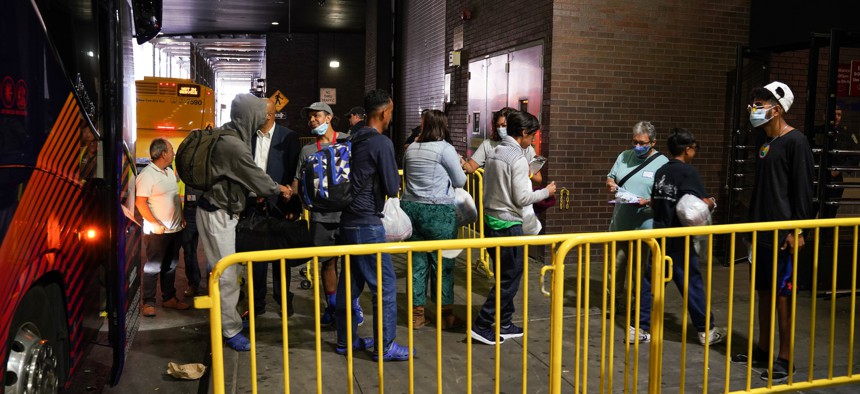Around 100 migrant families have moved into apartments upstate under a state program rolled out last year in an attempt to alleviate pressure on New York City.
According to the state Office of Temporary and Disability Assistance – the agency overseeing the Migrant Relocation Assistance Program – an additional 31 families have signed leases as of Jan. 10. Of the 443 families who’ve enrolled in the program, 299 are currently working with contracted service providers to connect them with housing in the community they’ve chosen to relocate, according to an office spokesperson. The participating counties are Westchester, Suffolk, Erie, Monroe and Albany.
The latest numbers mark significant progress from late summer when New York Focus reported that zero families had been relocated as of the end of August. Still, the number of leases make up roughly 10% of the 1,250 families the program was initially funded for. New York City leaders have expressed frustrations over what they’ve described as slow progress to match the families the city has recommended with housing.
When asked about the hold up, a spokesperson for the governor’s office emphasized that the program is voluntary and said “finding the right size and type of placement for each family is important and that takes time.”
New York City officials have acknowledged obstacles the state is facing like limited housing options, but suggested that the state doesn’t have the same degree of urgency as the city.
“It’s not about having families that have their work authorization or have done their paperwork on the way, it’s really about how many units they have available,” New York City Deputy Mayor for Health and Human Services Anne Williams-Isom said in October. “I might be like, ‘let’s put an air mattress in there and let’s get this done.’ Somehow people don’t have the same sense of urgency I think that we do.”
The program, funded by a $25 million allocation in the state budget, was announced over the summer to move migrant families out of the New York City shelter system to counties upstate by offering them rental assistance for up to a year and a bevy of additional support, including case management and social services like employment counseling and transportation to help them assimilate into their new community. A network of nonprofits is working with the state to help find homes for asylum-seeking families who must sign a consent form that acknowledges they understand potential effects of relocation on their immigration case.
New York City has scrambled to accommodate the tens of thousands of migrants who’ve arrived in the city since spring 2020. Roughly 68,000 new arrivals remain in city shelters as of January – many of whom are families with children. The situation has only grown more unpredictable this week as the city began evicting the first wave of migrant families who’d reached their 60-day limit within the shelter system and requiring them to reapply for a new placement in an effort to urge new arrivals to find permanent housing.
The Migrant Relocation Assistance Program has been billed as a way to help migrant families find more suitable, long-term housing while also helping New York City manage the ongoing stream of arrivals.
“We can’t be the only one that has to be on demand and provide shelter and do everything with the mandates we have right now,” Williams-Isom said at a press briefing earlier this month. “I think it would help a lot if there was a way for the state to expedite that – moving more people up who are eligible until they find housing. I understand that it’s a challenge, but I think all of us have to be in this together.”
Rules requiring households to have at least one adult who has applied for asylum, Temporary Protected Status or other immigration relief have also limited the number of eligible families, an investigation from New York Focus found.
It’s unclear at this point whether Gov. Kathy Hochul will propose to renew funding for the program in her upcoming budget proposal. For advocates the benefits of such a program are clear – as is the need for more similar programs that will connect migrant families to permanent housing.
“It’s running up to become a very successful program,” said New York Immigration Coalition President Murad Awawdeh. “The government is one of the slowest aspects of life, so for how quick this program got set up, I give it credit that it’s actually moving forward in an impactful and helpful way.”


